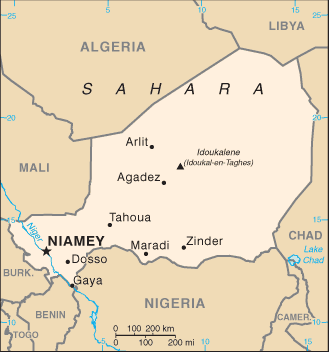Map:

Overview:
Not until 1993, 33 years after independence from France, did Niger hold its first free and open elections. A 1995 peace accord ended a five-year Tuareg insurgency in the north. Coups in 1996 and 1999 were followed by the creation of a National Reconciliation Council that effected a transition to civilian rule by December 1999. Niger is one of the poorest countries in the world with minimal government services and insufficient funds to develop its resource base. The largely agrarian and subsistence-based economy is frequently disrupted by extended droughts common to the Sahel region of Africa.
The People:
Population: 11,665,937 (July 2005 est.)
Age structure:
0-14 years: 47.3% (male 2,811,539/female 2,704,498)
15-64 years: 50.6% (male 2,890,119/female 3,009,281)
65 years and over: 2.1% (male 130,953/female 119,547) (2005 est.)
Religions:
Muslim 80%, remainder indigenous beliefs and Christian
Government Type:
republic
Leader(s) to pray for:
chief of state: President TANDJA Mamadou (since 22 December 1999); note - the president is both chief of state and head of government
Source: The World Factbook
View All Countries